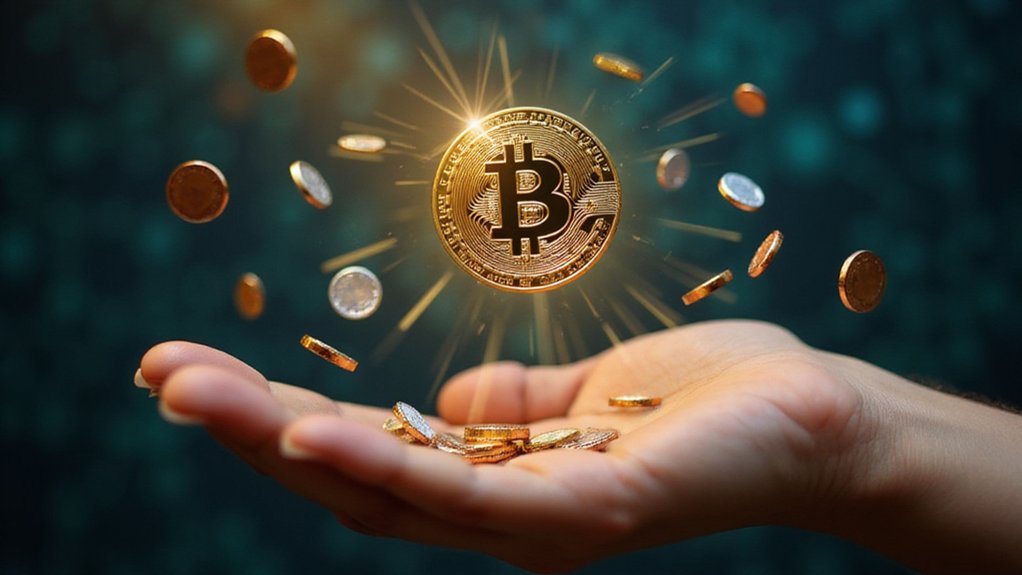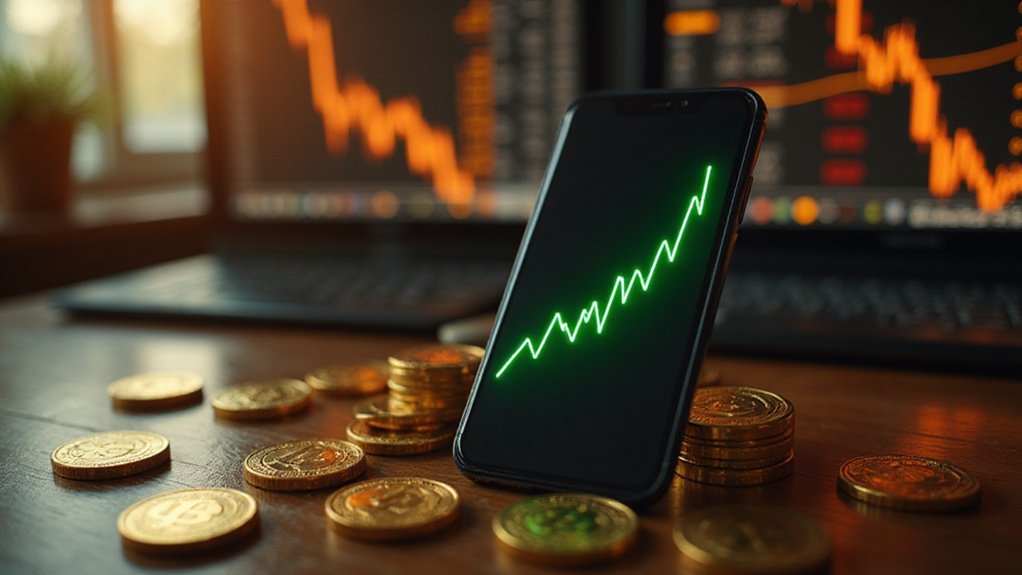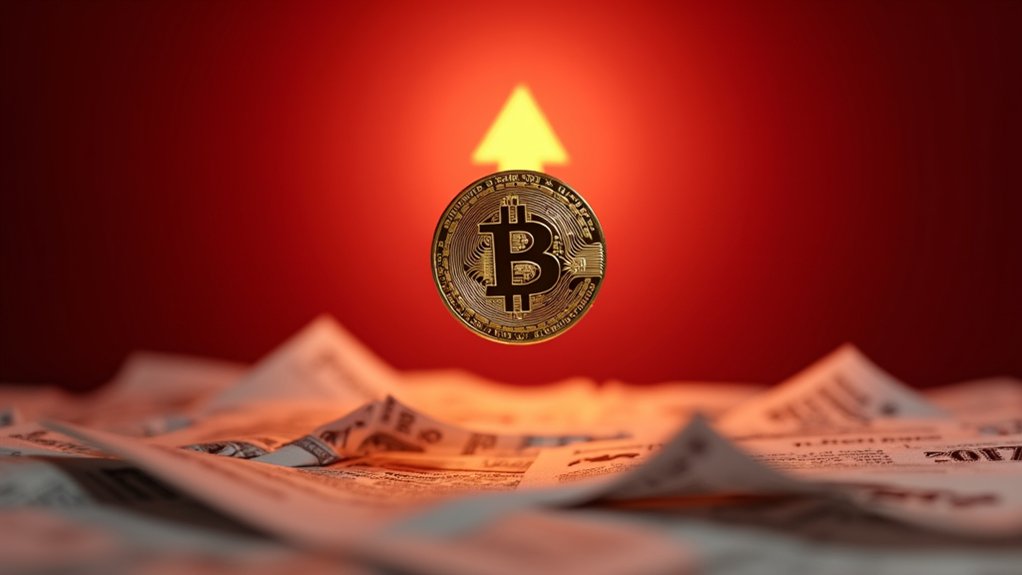Decentralized finance (DeFi) operates through smart contracts on blockchain networks like Ethereum, automatically executing lending, borrowing, and trading without traditional banks or payment processors. These programmable protocols eliminate intermediaries, allowing users to earn yield through liquidity provision while maintaining complete transaction transparency via distributed ledgers. Though the ecosystem has grown from $1 billion to over $120 billion in total value locked since 2020, smart contract vulnerabilities and regulatory uncertainty persist as significant risks. The implications extend far beyond simple financial automation.

How does one reconstruct the entire financial system without banks, brokers, or any of the traditional gatekeepers who have spent centuries convincing everyone they’re indispensable? The answer, according to DeFi enthusiasts, lies in blockchain technology and smart contracts—programmable code that executes financial agreements automatically, apparently without the charming inefficiencies of human oversight.
Decentralized Finance, coined in 2018, represents a fundamental departure from centralized financial systems where banks and payment processors control transactions through their benevolent authority.
Instead, DeFi operates on permissionless blockchains like Ethereum, where smart contracts eliminate intermediaries and enable peer-to-peer transactions.
This architecture distributes control among users rather than concentrating it within institutions that have traditionally profited from their middleman status.
The technology underlying DeFi relies on distributed ledger systems that create transparent, auditable records of all transactions.
Smart contracts automate lending, borrowing, trading, and yield farming without requiring approval from centralized authorities—a concept that presumably keeps traditional bankers awake at night.
The modular nature of these platforms allows different DeFi applications to interact seamlessly, creating an interconnected financial ecosystem.
DeFi’s promise extends beyond mere technological novelty.
It offers financial services to unbanked populations globally while potentially reducing costs through the elimination of intermediaries.
Users can earn interest through liquidity provision, trade derivatives on decentralized exchanges, and access insurance products—all without traditional gatekeepers determining their worthiness.
Users can also participate in yield farming by allocating their digital assets into protocols to receive rewards, often in the form of the protocol’s governance tokens.
However, this financial utopia comes with notable caveats.
Smart contract vulnerabilities have led to spectacular hacks, while the volatility inherent in cryptocurrency markets creates risks that would make traditional risk managers reach for their anxiety medication.
Regulatory uncertainty looms large, as governments struggle to classify systems that deliberately eschew centralized control.
The scalability limitations of current blockchain networks present additional challenges, often resulting in transaction fees that ironically exceed those charged by the supposedly obsolete traditional financial system.
User experience remains complex, creating barriers for mainstream adoption among those who find difficulty using conventional banking interfaces.
The sector’s remarkable growth trajectory shows DeFi’s total value locked expanding from $1 billion in 2020 to over $120 billion by 2025.
The DeFi ecosystem’s composable architecture enables aggregators to combine multiple protocols and create entirely new financial services that leverage the interoperability of different applications.
Since Bitcoin’s emergence in 2009, DeFi has evolved into a trillion-dollar industry, demonstrating that perhaps the financial system’s reconstruction is less theoretical question than inevitable reality.
Frequently Asked Questions
What Are the Main Risks of Using Defi Platforms?
DeFi platforms present a fascinating cocktail of technological and financial hazards.
Smart contract vulnerabilities enable sophisticated exploits—because who doesn’t trust immutable code written by anonymous developers?
Market volatility reaches spectacular heights, while regulatory uncertainty creates delightful legal gray areas.
Security breaches flourish in this decentralized paradise, complemented by information asymmetries that would make traditional finance blush.
Network congestion and scalability issues merely add technical seasoning to this risk buffet.
How Do I Get Started With Defi as a Beginner?
A beginner should establish a Web3-compatible wallet (MetaMask remains the default choice), acquire initial cryptocurrency for transaction fees, and start with established protocols like Aave or Uniswap rather than chasing exotic yields.
Given the previously discussed risks, beginning with small amounts allows experiential learning without catastrophic losses.
The permissionless nature means anyone can participate immediately—though whether they should represents an entirely different question requiring honest self-assessment of risk tolerance.
What Fees Should I Expect When Using Defi Services?
DeFi fees vary dramatically across platforms—Ethereum’s gas costs can spike during congestion (sometimes reaching absurd levels), while alternatives like Solana offer ultra-low transactions.
Users encounter base fees, priority fees, and complexity charges depending on smart contract interactions.
Stablecoin platforms like Infini target near-zero costs, though this remains aspirational.
Strategic timing, blockchain selection, and monitoring network activity help minimize expenses, though fee unpredictability remains DeFi’s persistent frustration.
Is Defi Legal in My Country?
DeFi’s legal status varies dramatically by jurisdiction—France mandates DASP registration, Mauritius actively develops supportive frameworks, while the U.S. navigates a labyrinthine state-by-state approach.
Most regions require licensing, KYC/AML compliance, and taxation adherence.
Countries with restrictive policies paradoxically witness continued peer-to-peer trading (proving regulation’s occasional futility).
Clear frameworks generally foster adoption and market stability, though the regulatory landscape remains fragmented globally, requiring careful jurisdictional analysis.
How Does Defi Compare to Traditional Banking Services?
DeFi operates through blockchain protocols with community governance, while traditional banking relies on centralized institutional control.
DeFi offers 24/7 permissionless access via smart contracts, whereas banks require KYC verification and operate within business hours.
Traditional finance provides regulatory protections and deposit insurance; DeFi delivers transparency and censorship resistance but transfers security responsibility to users.
The trade-off involves exchanging institutional oversight for direct protocol interaction—each serving distinct risk appetites and accessibility needs.









